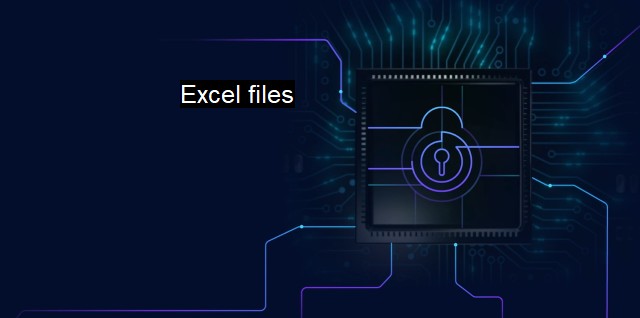What are Excel files?
How to Secure Excel Files: The Importance of Antivirus Software for Cybersecurity
"Excel files" are types of datasets that belong to a popular spreadsheet application from the Microsoft Office Suite known as Microsoft Excel. They are primarily used for storing, analyzing and processing data. Due to their interactive user-interface, they have been adopted across various industries such as finance, research, education, healthcare, and business due to their data manipulation proficiency and ease of use. Excel files are commonly distinguished by acceptable extensions reflecting its different versions, such as .xls (standard binary Excel workbook), .xlsx (Excel Open XML workbook), .xlsm (Macro-enabled workbook), .xlsb (Binary workbook), among others.Excel files, like all types of digital files, can be at risk of cyber threats leading to data manipulation, alteration or loss of data files, and unauthorized access—posing a significant threat to security and privacy. Cybersecurity is a defense measure that involves protecting data, networks, programs, and computers from threats or attacks, essentially preserving the integrity of data files like Excel files.
Cybercriminals exploit vulnerabilities in Excel files to deliver malicious software (malware). An outlying tactic is the artifact macro, small bits of code embedding which cater large operations. Posing as innocent files, the dangerous macros are used to automate redundant tasks, but cybercriminals exploit them to deliver malware by merely prompting users to enable macros. Upon opening infected .xls or .xlsm files, the whirring macro code triggers a payload such as a Trojan horse, ransomware, or a botnet participant—consequently subjecting the system into vulnerabilities.
One common Excel-based threat is the SYLK files carrying embedded macros, often disguised as regular or even encrypted Excel files. Despite the deployment modalities, their popularity resonates with how unsuspecting users are willingly tricked or even unaware of such threats. As Excel is a popular data handling tool, malware lodged within can spread infection throughout the network or lock users out of folders and subsequently demanding ransom.
Cybersecurity best practices advocate for regular inspection of Excel files within an entity's network. High-profile targets for cyber criminals include financial institutions, large enterprises, and organizations with an extensive database that must proactively instate stringent security checks on these Excel files to preempt significant losses or impending threats, suggesting improved awareness and practices.
Antivirus software plays paramount roles in shielding against threats. With heuristic and behavioral properties, they can detect and eradicate previously undefined malware strains by analyzing file properties and anticipating undiscovered threats. They can vicariously scan Excel files, identify and quarantine risky aspects, presenting a summary detailing the implications. Talented antivirus software developers continually improve capabilities, leading to efficient identification of encrypted malware, essentially defusing its detrimental impacts.
Regular updates are propagated to tackle evolving cyber threats. Therein they update firewall vintages and incorporation points for real-time protection, proving pivotal in maintaining Excel file safety. Indispensable antiviral features that salvage file security include online protection from corrupt downloads, enhanced browser protection, and overall proficient virus detection, primarily focusing on data integrity maintenance.
Software sandboxing allows antiviruses to virtually emulate Excel file procedures, setting traps for potential encryptions, rigorous inspection of processes, and stratification of unusual activities, keeping the hardware untarnished. granular controls, intrusion prevention systems, network analysis, and recovery toolkits offer compelling capabilities to excel-based threat management.
As endpoint devices increase, Excel files stored on disparate platforms necessitated defense measures inclusive of cloud-based services, laying foundations for cloud-concept based cybersecurity solutions.
The essence of maintaining cybersecurity within Excel files boils to regulated internet behaviors and deserved attention to detail. Practicing caution from downloading online files and exercising vigilance by acquiring the knowledge required for spotting scams or counterfeit identities represents essential practices from users.
Given this, it is by no surprise to see emerging cybersecurity trades interfusing tailored innovations with broad-based expertise focusing to combat the threats cold on Microsoft Excel files, essentially to preserve data integrity and the anticipated resounding threats in digital domains.

Excel files FAQs
What are Excel files and why are they important in cybersecurity?
Excel files are electronic spreadsheets that contain data in rows and columns. They are important in cybersecurity because they may contain sensitive information that cybercriminals can exploit for malicious purposes.Can Excel files be infected by viruses or malware?
Yes, Excel files can be infected by viruses or malware, just like any other computer file. Cybercriminals can embed malicious code in Excel files to launch attacks on a computer or network.How can I protect my Excel files from viruses or malware?
You can protect your Excel files from viruses or malware by running antivirus software on your computer, keeping your operating system and software programs up to date with the latest security patches, and avoiding opening suspicious email attachments or downloading files from untrusted websites.What should I do if I suspect my Excel file has been infected with a virus or malware?
If you suspect your Excel file has been infected with a virus or malware, you should immediately isolate the infected file on your computer, run a virus scan, and delete or quarantine any threats detected by your antivirus software. You should also change any passwords or login credentials associated with the infected file as soon as possible.| | A | | | B | | | C | | | D | | | E | | | F | | | G | | | H | | | I | | | J | | | K | | | L | | | M | |
| | N | | | O | | | P | | | Q | | | R | | | S | | | T | | | U | | | V | | | W | | | X | | | Y | | | Z | |
| | 1 | | | 2 | | | 3 | | | 4 | | | 7 | | | 8 | | |||||||